Oil Filters RevealedReference Filter |
| Home | Engine | Drivetrain | Electrical | Chassis | Interior | General |
[ Overview | Opinions and Recommendations | Update History | Frequently Asked Questions ]






One weekend in early February of 1999, I set out to every auto parts store in my area and bought every brand of oil filter I could find. The reference filter that I chose is a common filter used on many Chrysler/Ford engines, which also fits various Jeep, Mazda, and Toyota applications. The reason is that this is a popular filter used in many applications, it is large so that it will unveil any fake miniature internal components, and it works with the Chrysler 2.2L and 2.5L engines. Design-wise it is fully compatible with the 2.2L/2.5L oil systems and is an excellent replacement for the tiny "teacup" filter that was originally designed for these engines. I was able to find nearly 30 different filters spanning several brand names.
While the primary focus of the effort was on this common filter for domestic applications, I have also taken a look at the following other filters:
The analysis is sorted by brand name in alphabetical order. In each brand section, the information is broken down into the brand name models, sorted by price. Detailed sections of some of the models follow, though not all filters listed have them. Filters tested only in 1999 have the vintage specified as such. If they have been verified as unchanged since then, they are labeled 1999-2008. If a filter has never been acquired, the vintage is marked as N/A. Note that even though the surface area is listed for comparison, the values don't correspond exactly to the filters' holding capacity. This is a function of the media's composition as well as the surface area, which is not something I am equipped to compare. However for filters in similar price ranges, it is reasonable to assume that the filter medias are somewhat comparable.
| Brand | Model | P/N | Vintage | Manufacturer | Cost | Element Surface Area |
| AC Delco | Duraguard | PF2 | 1999 | AC Delco | $3 | 315 sqin |
| Duraguard | PF2 | 2008 | Champion Labs (Ecore) | $3 | ? | |
| AC Delco | PF-2C | 1999 | AC Delco (Canada) | ? | 255 sqin | |
| AMSOIL | SuperDuty | SDF15 | 1999 | Baldwin/Hastings | $8 | 270 sqin |
| Absolute Efficiency | EAO15 | N/A | Donaldson? | $15 | ? | |
| Baldwin | Baldwin | B2 | 1999-2008 | Baldwin/Hastings | $5 | 298 sqin |
| Bosch | Premium | 3500 | 1999 | Champion Labs (old design) | $3 | 337 sqin |
| Premium | 3500 | 2008 | Purolator | $6 | 375 sqin | |
| Car And Driver | Car And Driver | SF-1A | 1999 | Champion Labs | $3 | 337 sqin |
| CarQuest | Red | 85515 | N/A | Dana/WIX | $7 | ? |
| Blue | 85515 | N/A | Dana/WIX | $12 | ? | |
| Castrol | MaxPro | CM8A | 1999 | Dana/WIX | $3 | 294 |
| MaxPro Plus | CMP8A | 1999 | Dana/WIX | $6 | 298 | |
| Champ | Champ | PH8 | N/A | Champion Labs | $3 | 337 sqin |
| Deutsch | Deutsch | D539 | 1999 | Champion Labs | $3 | 343 sqin |
| Deutsch | D545 | 1999 | Champion Labs | $3 | ? | |
| Fram | Extra Guard | PH8A | 1999-2008 | Honeywell (was Allied-Signal) | $4 | 193 sqin |
| Tough Guard | TG8A | 1999-2008 | Honeywell (was Allied-Signal) | $7 | 248 sqin | |
| Double Guard | DG8A | 1999 | Allied-Signal | $10 | 193 sqin | |
| High Mileage | HM8A | 2008 | Honeywell | $8 | 197 sqin | |
| Hard Driver | Hard Driver | HD01 | 1999 | Donaldson | $8.50 | 195 sqin |
| Hastings | Premium | LF115 | N/A | Baldwin/Hastings | $6 | ? |
| K&N | Performance Gold | HP-3001 | 1999-2008 | Champion Labs (old design) | $12 | 362 sqin |
| Mobil | Mobil 1 | M1-301 | 1999-2008 | Champion Labs (old design) | $10 | 356 sqin |
| Motorcraft | Long Lasting | FL-1A | 1999-2008 | Purolator | $4 | 296 sqin |
| MotorMaster | MotorMaster | PH8A | 1999 | Honeywell (was Allied-Signal) | ? | 202 sqin |
| NAPA | Silver/ProSelect | 51515 | N/A | Dana/WIX | $3 | ? |
| Gold | 1515 | 1999-2008 | Dana/WIX | $5 | 337 sqin | |
| Pennzoil | Pennzoil | PZ-1 | 1999 | Honeywell (was Allied-Signal) | $2 | 193 sqin |
| Penske | Penske | PN8A | 1999 | Dana/WIX | $5 | 274 sqin |
| PowerFlo | PowerFlo | SL30001 | 1999 | Purolator | $2 | 316 sqin |
| ProLine | ProLine | PPL-30001 | 1999 | Purolator | $3 | 316 sqin |
| Purolator | Premium Plus | L30001 | 1999-2008 | Purolator | $3 | 316 sqin |
| Pure One | PL30001 | 1999 | Purolator | $6 | 400 sqin | |
| Quaker State | Quaker State | Q58A | 1999 | Purolator | $3 | 316 sqin |
| Quaker State | Q58A | 2001 | Honeywell (was Allied-Signal) | $3 | ? | |
| Ryco | Premium | Z9 | 1999 | GUD Manufacturing | ? | 490 sqin |
| STP | STP | S-01 | 1999 | Champion Labs (old design) | $3 | 360 sqin |
| STP | S8A | 2008 | Champion Labs (Ecore) | $3 | 297 sqin | |
| WIX | WIX | 51515 | 1999-2008 | Dana/WIX | $5 | 349 sqin |
2008 Version
A few years after this study was initially done, the PF2 model of the AC Delco filters seemed to disappear from the shelves of the stores nearby. Sometime around 2004-2005 when Champion Labs launched their new "Ecore" filter design, US-sold AC Delco filters became Champion Labs filters. It seems that AC Delco got out of the oil filter manufacturing business (at least in the US). Since it is now a Champ clone, keep an eye on who is making your AC Delco filter.
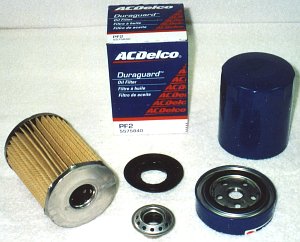 The filter cartridge has a large outside diameter with deep pleats. At first glance, it appears to have little filter element media, but the surface area measure was surprising: 315 sqin. The unit had a solid top end cap because the bypass valve is at the bottom, which is a well constructed spring-loaded steel with a nitrile seal design. The nitrile rubber diaphragm-type anti-drainback valve doubles as the seal between the bypass valve and the cartridge. The only drawback to this design is that the bypass valve seats metal-to-metal against the backplate. This could allow oil from the clean side of the filter to seep back into the oil pan, but it wouldn't allow the dirty oil in the filter to seep back. Oil that is in the main gallery usually leaks out through the main bearings anyway while the engine sits. One disadvantage to the AC Delco is that the anti-drainback valve seals against a rough backplate. I noticed that if I blow air through the oil outlet, air slowly leaks past the valve. Even so, I have received testimonials that the AC Delco stops the valve train noise problems associated with the Fram filter, so it may seal fine once it has been exposed to oil (it worked fine for me). The WIX and Purolator filters seal perfectly.
The filter cartridge has a large outside diameter with deep pleats. At first glance, it appears to have little filter element media, but the surface area measure was surprising: 315 sqin. The unit had a solid top end cap because the bypass valve is at the bottom, which is a well constructed spring-loaded steel with a nitrile seal design. The nitrile rubber diaphragm-type anti-drainback valve doubles as the seal between the bypass valve and the cartridge. The only drawback to this design is that the bypass valve seats metal-to-metal against the backplate. This could allow oil from the clean side of the filter to seep back into the oil pan, but it wouldn't allow the dirty oil in the filter to seep back. Oil that is in the main gallery usually leaks out through the main bearings anyway while the engine sits. One disadvantage to the AC Delco is that the anti-drainback valve seals against a rough backplate. I noticed that if I blow air through the oil outlet, air slowly leaks past the valve. Even so, I have received testimonials that the AC Delco stops the valve train noise problems associated with the Fram filter, so it may seal fine once it has been exposed to oil (it worked fine for me). The WIX and Purolator filters seal perfectly.
It seems that AC Delco no longer makes this filter for this application (or the Chrysler 2.2L/2.5L for that matter). I have not been able to find it in any location near me.
The telltale signs for an AC Delco filter are: Five large holes for the oil inlet and 6 spot welds on the rim surrounding them. There are no crimps holding the gasket in place. When you look through the inlet holes, you can see the metal bypass valve with its 12 small holes and the black anti-drainback valve diaphragm around it. Through the center outlet hole, you can see the spring for the bypass valve.
Exploded view:

| Average Retail Price | $3 |
| Cartridge Length | 4.63 inches |
| Cartridge Outside Diameter | 3.38 inches |
| Cartridge Inside Diameter | 1.38 inches |
| Cartridge Pleats | 36 |
| Cartridge End Cap Type | Stamped steel |
| Anti-Drainback Valve Type | Nitrile rubber diaphragm |
| Bypass Valve Type | Spring-loaded steel |
| Element Type | Paper media, glued seam |
| Element Length | 70.0 inches |
| Element Width | 4.50 inches |
| Element Surface Area | 315 square inches |
| Shell Thickness | 0.015 inches |
| Backplate Thickness | 0.10 inches |
| Gasket Type | Nitrile rubber |
This is another version of the same filter manufactured by AC Delco in Canada in 1999.&nsbp; With the switch to Champion Labs for US-sold AC Delco filters, it is unclear if the same is now true for Canada.
Exploded view:

| Average Retail Price | ? |
| Overall Length | 5.13 inches |
| Overall Diameter | 3.62 inches |
| Cartridge Length | 4.06 inches |
| Cartridge Outside Diameter | 3.30 inches |
| Cartridge Inside Diameter | 1.52 inches |
| Cartridge Pleats | 41 |
| Cartridge End Cap Type | Stamped steel, with bypass valve in back |
| Anti-Drainback Valve Type | Nitrile rubber diaphragm |
| Bypass Valve Type | Spring-loaded steel/rubber |
| Element Type | Cellulose media, steel seam |
| Element Length | 68 inches |
| Element Width | 3.75 inches |
| Element Surface Area | 255 square inches |
| Shell Thickness | 0.017 inches |
| Backplate Thickness | 0.10 inches |
| Gasket Type | Nitrile rubber |
This filter is no longer being sold by AMSOIL. It was manufactured by Baldwin/Hastings. AMSOIL's new EaO series of filters replace these and are of a completely different design. They are intended for long duration use (25,000 miles or 1 year) when used with their full synthetic motor oil. Interestingly, AMSOIL also sells WIX filters for their other oils. Thankfully, they are sold as WIX-branded filters instead of branding them as their own and confusing everyone.
Exploded view and backplate:

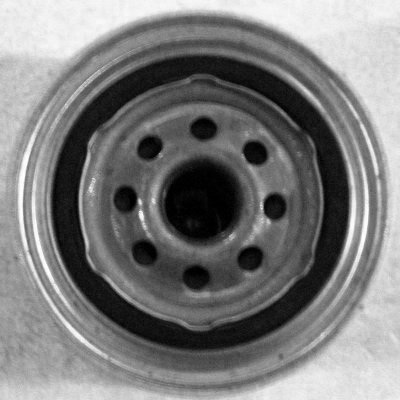
| Average Retail Price | $8 |
| Overall Length | 5.28 inches |
| Overall Diameter | 3.72 inches |
| Cartridge Length | 4.25 inches |
| Cartridge Outside Diameter | 3.37 inches |
| Cartridge Inside Diameter | 1.68 inches |
| Cartridge Pleats | 44 |
| Cartridge End Cap Type | Stamped steel, with bypass valve in back |
| Anti-Drainback Valve Type | Nitrile rubber diaphragm |
| Bypass Valve Type | Spring-loaded steel |
| Element Type | Synthetic media, steel seam |
| Element Length | 67.5 inches |
| Element Width | 4.0 inches |
| Element Surface Area | 270 square inches |
| Shell Thickness | 0.016 inches |
| Backplate Thickness | 0.10 inches |
| Gasket Type | Nitrile rubber |
The Baldwin filter is a well-designed and well-built unit. It seems to be highly-regarded in truck applications and has filters available for any vehicle application. It features a spring-loaded metal bypass valve and a nitrile rubber diaphragm-type anti-drainback valve, which doubles as the seal between the backplate and the cartridge. The bypass valve is stamped right into the end cap of the cartridge. The cartridge is held in place by a large, stiff coil spring.
The internal design of the Baldwin/Hastings filter cartridge has changed slightly since 1999. The bypass valve has moved from the back of the cartridge to a ring around the oil outlet at the front. This is a minor change that does not consume any additional space from the cartridge in the case.
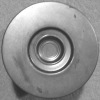
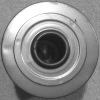

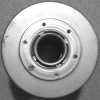
1999 Baldwin on the left, 2008 Baldwin on the right
Baldwin and Hastings seem to have merged or were bought by the same filtration product company: CLARCOR. They both list their headquarters and the same address in Kearney, Nebraska and the picture of the building on each website is the same picture with the Baldwin name removed from the Hastings photo. Looking around the web, very few online vendors seem to carry Hastings products. However Hastings filters are still available through normal distribution channels, mainly for truck applications.
Exploded view:


| Average Retail Price | $5 |
| Overall Length | 5.25 inches |
| Overall Diameter | 3.69 inches |
| Cartridge Length | 4.25 inches |
| Cartridge Outside Diameter | 3.47 inches |
| Cartridge Inside Diameter | 1.68 inches |
| Cartridge Pleats | 44 |
| Cartridge End Cap Type | Stamped-steel, with bypass valve in front |
| Anti-Drainback Valve Type | Nitrile rubber diaphragm |
| Bypass Valve Type | Spring-loaded nitrile rubber |
| Element Type | ? |
| Element Length | 74.5 inches |
| Element Width | 4.0 inches |
| Element Surface Area | 298 square inches |
| Shell Thickness | 0.017 inches |
| Backplate Thickness | 0.10 inches |
| Gasket Type | Nitrile rubber |
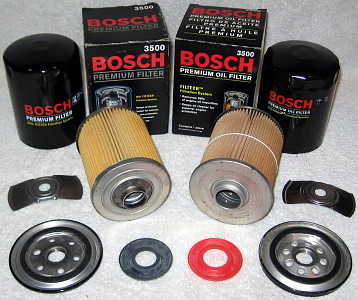
1999 Bosch on the left (Champion Labs), 2008 Bosch on the right (Purolator).
In 1999, this filter was made by Champion Labs. Looking at this filter again in 2008 revealed it as a Purolator. While Bosch may manufacture their own filters in Germany, they contract other companies for sales in the US. Both are supposed have "Filtech" technology, but the filter element in each do not appear to be the same. They are more similar to the elements found in each respective manufacturer's filters. Perhaps "Filtech" is just a specification given to the manufacturer. Either way there is nothing obviously unique about the Bosch filter relative to any other Champion Labs/Purolator filter with the exception of the silicon anti-drainback valve on the Purolator version.
| Average Retail Price | $6 |
| Overall Length | 5.25 inches |
| Overall Diameter | 3.66 inches |
| Cartridge Length | 4.13 inches |
| Cartridge Outside Diameter | 3.42 inches |
| Cartridge Inside Diameter | 1.73 inches |
| Cartridge Pleats | 63 |
| Cartridge End Cap Type | Stamped steel, with bypass valve in back |
| Anti-Drainback Valve Type | Nitrile rubber diaphragm |
| Bypass Valve Type | Spring-loaded steel |
| Element Type | Blended media, steel seam |
| Element Length | 96 inches |
| Element Width | 3.88 inches |
| Element Surface Area | 372 square inches |
| Shell Thickness | 0.014 inches |
| Backplate Thickness | 0.10 inches |
| Gasket Type | Nitrile rubber |
| Average Retail Price | $3 |
| Overall Length | 5.13 inches |
| Overall Diameter | 3.65 inches |
| Cartridge Length | 4.0 inches |
| Cartridge Outside Diameter | 3.36 inches |
| Cartridge Inside Diameter | 1.65 inches |
| Cartridge Pleats | 63 |
| Cartridge End Cap Type | Stamped steel, with bypass valve in front |
| Anti-Drainback Valve Type | Nitrile rubber diaphragm |
| Bypass Valve Type | Spring-loaded steel, nitrile seal |
| Element Type | Blended media, glued seam |
| Element Length | 100 inches |
| Element Width | 3.75 inches |
| Element Surface Area | 375 square inches |
| Shell Thickness | 0.014 inches |
| Backplate Thickness | 0.10 inches |
| Gasket Type | Nitrile rubber |
This filter is manufactured by Champion Laboratories, Inc. (not related to Champion spark plugs), and is sold under several other brand names. Champion Labs is a conglomeration of several different companies that merged and split in the 50 years or so that it has been around. Originally part of Pyroil in 1959, they have been bought and sold several times over the years by companies such as STP and UIS and have acquired brands such as Kleen Pak, Luber-Finer, and Lee. They are now part of United Components, Inc., part of the Carlyle Group investment firm.

From left to right: 1999 filter, 2008 "Ecore" filter, 2008 "Performance" filter.
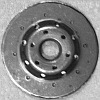 In 2004/2005, Champion Labs began production of their new "Ecore" filter design. It is quite different from their earlier design. Rather than steel, the cartridge uses some sort of fiber end caps that are thermally bonded to the filter element. It was quite easy to peel the end cap off of the filter element with my fingers and at least one example has some pleats that were not bonded at all on one side. The steel inner core tube has been replaced with a nylon frame, which seems fairly strong. The anti-drainback and bypass valves have been combined into a single valve that covers two sets of holes in the backplate. The bypass valve portion seems to use the pressure of the filter cartridge itself against valve to cover the inner set of holes in the backplate. This implies that the pressure exerted by the spring at the top of the filter is critical. The spring is still just a stamped steel leaf-type spring which may or may not provide accurate spring pressure. This also means that if the back of the can is dented, as was the case with the STP filter I purchased, the bypass pressure may be effected. The overall length of the "Ecore" filter is about 1 inch shorter than the previous design. Part of this is due to the elimination of the separate bypass valve, but the width of the media is also about 1/2 inch shorter on the "Ecore". It's unfortunate that they did not take advantage of the extra space to add additional filter surface. Instead they cut costs and shrunk the can.
In 2004/2005, Champion Labs began production of their new "Ecore" filter design. It is quite different from their earlier design. Rather than steel, the cartridge uses some sort of fiber end caps that are thermally bonded to the filter element. It was quite easy to peel the end cap off of the filter element with my fingers and at least one example has some pleats that were not bonded at all on one side. The steel inner core tube has been replaced with a nylon frame, which seems fairly strong. The anti-drainback and bypass valves have been combined into a single valve that covers two sets of holes in the backplate. The bypass valve portion seems to use the pressure of the filter cartridge itself against valve to cover the inner set of holes in the backplate. This implies that the pressure exerted by the spring at the top of the filter is critical. The spring is still just a stamped steel leaf-type spring which may or may not provide accurate spring pressure. This also means that if the back of the can is dented, as was the case with the STP filter I purchased, the bypass pressure may be effected. The overall length of the "Ecore" filter is about 1 inch shorter than the previous design. Part of this is due to the elimination of the separate bypass valve, but the width of the media is also about 1/2 inch shorter on the "Ecore". It's unfortunate that they did not take advantage of the extra space to add additional filter surface. Instead they cut costs and shrunk the can.
Interestingly, two performance filter brands that are manufactured by Champion Labs still use the old design. They are Mobil 1 and K&N. Examples of each purchased in 2008 were not "Ecore" filters. It seems that any old stock should have been sold by now. This raises the possibility that the "Ecore" design, with it's fiber end caps and plastic core tube, are not suitable for high pressure/flow use.
The telltale signs for an "Ecore" Champion Labs filter are: 8 large holes in a smooth, thin backplate cover with the real backplate behind it. The real backplate has two sets of holes (difficult to see) with 6 small holes in the inner ring (bypass inlet) and 8 larger holes in the outer ring (filter inlet). The real backplate threads protrude through the backplate cover in the center. Through the center outlet hole, you can see the cone-shaped center of the leaf spring.
Exploded view and backplate of an "Ecore" filter:

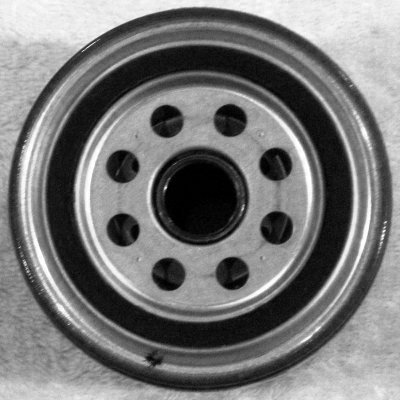
The telltale signs for the "performance" Champion Labs filter design are: 8 large holes in a thick backplate with one hole slightly larger than the others. Only the anti-drainback valve can be seen through the inlet holes. Through the center outlet hole, you can see the smooth back of the cartridge and the bypass valve spring off to the side.
Exploded view and backplate of a "performance" filter:


1999 Version
The 1999 Champion design has metal end caps on the filter cartridge, with the bypass valve stamped right into the bottom end cap like the Purolator. I refer to this as a one-piece filter cartridge. Though definitely not the same design as the Purolator, it does use the same type of leaf-spring-type spacer at the top of the cartridge and the nitrile anti-drainback valve, which doubles as the cartridge-to-backplate seal, at the bottom. One issue is that I sometimes noticed was some rust on the backplate of these filters. Since the rust is usually around by the inlet holes, any loose rust would be caught by the filter.
The telltale signs for a 1999 Champion filter are: 6 large holes for the oil inlet, one of which is larger than the others. Only the black anti-drainback valve can be seen through the inlet holes. There are 6 large crimps holding the gasket in place. Through the center outlet hole, you can see the bypass valve spring. Usually, the backplate metal is dull, or even rusty.
Exploded view and backplate of a 1999 filter:

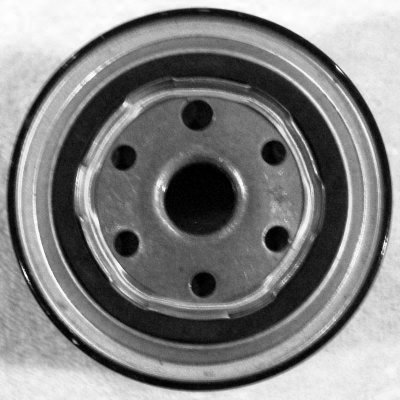
This filter is a Champion Labs filter.
| Average Retail Price | $3 |
| Cartridge Length | 4.00 inches |
| Cartridge Outside Diameter | 3.25 inches |
| Cartridge Inside Diameter | 1.63 inches |
| Cartridge Pleats | 55 |
| Cartridge End Cap Type | Stamped-steel, with bypass valve in front |
| Anti-Drainback Valve Type | Nitrile rubber diaphragm |
| Bypass Valve Type | Spring-loaded steel, nitrile seal |
| Element Type | Paper media, glued seam |
| Element Length | 88.5 inches |
| Element Width | 3.88 inches |
| Element Surface Area | 343 square inches |
| Shell Thickness | 0.012 inches |
| Backplate Thickness | 0.10 inches |
| Gasket Type | Nitrile rubber |
While Fram has been around since 1934, Honeywell (formerly Allied-Signal, formerly Bendix) has been manufacturing Fram filters since they bought-out the company in 1967. While I don't know when they started making them like this, I suspect it has been for many decades. See this 1999 email from an Allied Signal production engineer. Also see episode 41 of the TV show "How It's Made" for a look at the production line for these filters. Fram filters are sold pretty much anywhere oil filters are sold.
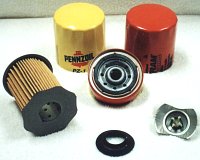 This filter cartridge has a small outside diameter with a rather low filter element surface area (193 sqin), and features cardboard end caps that are bonded in place using a thermal adhesive. The rubber anti-drainback valve seals the rough metal backplate to the cardboard end cap. In practice these seem to leak, causing dirty oil to drain back into the pan. If you use this filter and have a noisy valve train at startup, the filter is likely the cause. The bypass valves are plastic and are sometimes not molded correctly, which allows them to leak when they should be closed. The backplate has smaller and fewer oil inlet holes, which may restrict flow.
This filter cartridge has a small outside diameter with a rather low filter element surface area (193 sqin), and features cardboard end caps that are bonded in place using a thermal adhesive. The rubber anti-drainback valve seals the rough metal backplate to the cardboard end cap. In practice these seem to leak, causing dirty oil to drain back into the pan. If you use this filter and have a noisy valve train at startup, the filter is likely the cause. The bypass valves are plastic and are sometimes not molded correctly, which allows them to leak when they should be closed. The backplate has smaller and fewer oil inlet holes, which may restrict flow.
The telltale signs for a Fram Extra Guard are: It has 8 small holes for the oil inlet and a thin-looking backplate. There are 5 very small crimps holding the gasket in place. If you look into the center hole all the way to the top of the filter, you will see a kind of "button" in the end cap of the cartridge (which looks like it's made of metal from there). This is the plastic bypass valve.
Exploded view and backplate:


| Average Retail Price | $3 |
| Cartridge Length | 4.13 inches |
| Cartridge Outside Diameter | 3.00 inches |
| Cartridge Inside Diameter | 1.38 inches |
| Cartridge Pleats | 34 |
| Cartridge End Cap Type | Cardboard |
| Anti-Drainback Valve Type | Nitrile rubber diaphragm |
| Bypass Valve Type | Spring-loaded plastic |
| Element Type | Paper media, stamped metal seam |
| Element Length | 47.5 inches |
| Element Width | 4.06 inches |
| Element Surface Area | 193 square inches |
| Shell Thickness | 0.015 inches |
| Backplate Thickness | 0.089 inches |
| Gasket Type | Nitrile rubber |
This filter has an improved filter element with more surface area (248 sqin), a heavy silicone anti-drainback valve with a good sealing surface, the same plastic pressure relief valve but with an integral screen to keep out large particles, and enough inlet holes for good flow. In my opinion, the only real drawback to this filter is that it is capped on each end with cardboard instead of metal.
The telltale signs for a Fram Tough Guard filter are: a thicker backplate that is usually shiny, with six larger holes for the inlet and 6 spot welds around the them. There are 6 large crimps holding the gasket in place. When you look through the inlet holes, you can see the orange anti-drainback valve. If you look into the center hole all the way to the top of the filter, you will see a kind of "button" in the end cap of the cartridge (which looks like it's made of metal from there). This is the plastic bypass valve.
| Average Retail Price | $5 |
| Cartridge Length | 4.13 inches |
| Carridge Outside Diameter | 3.000 inches |
| Cartridge Inside Diameter | 1.63 inches |
| Cartridge Pleats | 50 |
| Cartridge End Cap Type | Cardboard |
| Anti-Drainback Valve Type | Silicone rubber diaphragm |
| Bypass Valve Type | Spring-loaded plastic with integral screen |
| Element Type | Paper media, stamped metal seam |
| Element Length | 61.0 inches |
| Element Width | 4.06 inches |
| Element Surface Area | 248 square inches |
| Shell Thickness | 0.015 inches |
| Backplate Thickness | 0.18 inches |
| Gasket Type | Nitrile rubber, PTFE-treated |
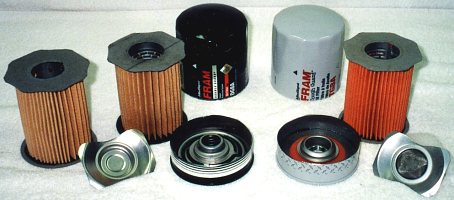
Far Left: extra guard cartridge. Left: Double Guard. Right: Tough Guard
This was one of the most expensive filters you could buy in 1999. Inside is a basic Fram Extra Guard (PH8A) filter element that has larger diameter holes at the end and has been preoiled. You can see this in the picture above (far left). I assume this is to hold the Teflon particles in the filter element before the unit is installed. Don't put Teflon in your engine. It does not belong there! DuPont does not recommend using their Teflon product in internal combustion engines.
Although it has the lowest filter element surface area (193 sqin), it does have a clever spring-loaded nitrile rubber anti-drainback valve and bypass valve combination.
The telltale signs for a Fram Tough Guard filter are: It has a better backplate that is usually shiny, with six larger holes for the inlet and 6 spot welds around the them. There are 6 large crimps holding the gasket in place. The anti-drainback valve diaphragm behind the inlet holes is black. If you look into the center hole all the way to the top of the filter, you will not see the "button" in the end cap of the cartridge like the other Fram filters.
| Average Retail Price | $10 |
| Cartridge Length | 4.13 inches |
| Cartridge Outside Diameter | 3.00 inches |
| Cartridge Inside Diameter | 1.63 inches |
| Cartridge Pleats | 38 |
| Cartridge End Cap Type | Cardboard |
| Anti-Drainback Valve Type | Nitrile rubber diaphragm |
| Bypass Valve Type | Nitrile rubber, integral |
| Element Type | Paper media, stamped metal seam |
| Element Length | 47.5 inches |
| Element Width | 4.06 inches |
| Element Surface Area | 193 square inches |
| Shell Thickness | 0.015 inches |
| Backplate Thickness | 0.18 inches |
| Gasket Type | Nitrile rubber |
 This is another trendy Fram filter. I don't see the Double Guard around anymore, as the Teflon craze has long gone out of style. The new trend in oil lately are these "high mileage" oils. It seems that Fram didn't want to be left out. This filter is a regular Fram Extra Guard filter with a plastic cartridge suspended inside the inner tube filled with some sort of goo. It is supposed to help those high mileage engines. The goo cartridge is on the clean side of the filter and is blocking the filter outlet. The oil can get around the cartridge, but it has to pass between it and the core tube which is a small gap. I don't know how long it takes for the goo to dissolve and I'd be concerned that it could exit the filter in a big glob. That could cause all kind of problems if an oil passage became blocked by this stuff. Even after the goo dissolves, the plastic cartridge will continue to block the oil flow exiting the filter. This may not be a problem for Fram however, since they employ such small oil inlet holes in the first place.
This is another trendy Fram filter. I don't see the Double Guard around anymore, as the Teflon craze has long gone out of style. The new trend in oil lately are these "high mileage" oils. It seems that Fram didn't want to be left out. This filter is a regular Fram Extra Guard filter with a plastic cartridge suspended inside the inner tube filled with some sort of goo. It is supposed to help those high mileage engines. The goo cartridge is on the clean side of the filter and is blocking the filter outlet. The oil can get around the cartridge, but it has to pass between it and the core tube which is a small gap. I don't know how long it takes for the goo to dissolve and I'd be concerned that it could exit the filter in a big glob. That could cause all kind of problems if an oil passage became blocked by this stuff. Even after the goo dissolves, the plastic cartridge will continue to block the oil flow exiting the filter. This may not be a problem for Fram however, since they employ such small oil inlet holes in the first place.
Leave the lubrication to the oil companies and the filtering to the filter companies. If you want to run a special "high-mileage" oil, buy a high-mileage oil and use goo-free filters instead.
Exploded view:


| Average Retail Price | $8 |
| Overall Length | 5.13 inches |
| Overall Diameter | 3.67 inches |
| Cartridge Length | 4.13 inches |
| Cartridge Outside Diameter | 2.93 inches |
| Cartridge Inside Diameter | 1.46 inches |
| Cartridge Pleats | 35 |
| Cartridge End Cap Type | Cardboard |
| Anti-Drainback Valve Type | Nitrile rubber diaphragm |
| Bypass Valve Type | Spring-loaded plastic |
| Element Type | Paper media, stamped metal seam |
| Element Length | 48.5 inches |
| Element Width | 4.06 inches |
| Element Surface Area | 197 square inches |
| Shell Thickness | 0.015 inches |
| Backplate Thickness | 0.089 inches |
| Gasket Type | Nitrile rubber |
This filter was one of the first to use a fully-synthetic, depth-gradient filter element media. The idea is that the media's density increases as the oil passes through, trapping smaller and smaller particles deeper in the filter. Thus the media can hold far more particles per square inch than a conventional media (making a surface area comparison with other filters rather meaningless). The filters were manufactured by Donaldson Filtration Solutions for Old World Industries through the "Peak" brand name. Unfortunately, the filter is no longer being made. The Fram X2 filter cartridge looked similar in design to the Hard Driver, except for the cardboard end caps on the Fram. The X2 also seems to have been taken off the market. The AMSOIL EaO series of filters use this same type of media and are specifically designed for long-duration use. The only problem noted when using this filter was that the gasket had a tendency to fall out of its channel during filter installation. A little grease to hold it on solved that issue, though.
Exploded view:

| Average Retail Price | $8.50 + $4 shipping |
| Overall Length | 5.25 inches |
| Overall Diameter | 3.67 inches |
| Cartridge Length | 4.13 inches |
| Cartridge Outside Diameter | 3.21 inches |
| Cartridge Inside Diameter | 1.69 inches |
| Cartridge Pleats | 36 |
| Cartridge End Cap Type | Stamped steel, with bypass valve in back |
| Anti-Drainback Valve Type | Nitrile rubber diaphragm |
| Bypass Valve Type | Spring-loaded steel, nitrile seal |
| Element Type | Synthetic media |
| Element Length | 52 inches |
| Element Width | 3.75 inches |
| Element Surface Area | 195 square inches |
| Shell Thickness | 0.016 inches |
| Backplate Thickness | 0.10 inches |
| Gasket Type | Nitrile rubber o-ring type |
This filter is a very close match to the Mobil 1 filter, which like this one also uses the original "performance" version of the Champion Labs design. The only unique attribute to this filter is the nut welded to the back of the can. This may be handy during removal, but it does increase the overall length of the can which can lead to clearance problems if things are already tight. They make oil filter wrenches in various styles for a reason. The K&N is an expensive filter for what it is, and you can save $2 by getting the Mobil 1 instead.
Exploded view:

| Average Retail Price | $12 |
| Overall Length | 5.75 inches (including the hex head) |
| Overall Diameter | 3.66 inches |
| Cartridge Length | 4.19 inches |
| Cartridge Outside Diameter | 3.36 inches |
| Cartridge Inside Diameter | 1.70 inches |
| Cartridge Pleats | 57 |
| Cartridge End Cap Type | Stamped steel, with bypass valve in front |
| Anti-Drainback Valve Type | Nitrile rubber diaphragm |
| Bypass Valve Type | Spring-loaded steel |
| Element Type | Synthetic blend media, glued seam |
| Element Length | 90.5 inches |
| Element Width | 4.0 inches |
| Element Surface Area | 362 square inches |
| Shell Thickness | 0.020 inches |
| Backplate Thickness | 0.14 inches |
| Gasket Type | Nitrile rubber |
This filter is made by Champion Labs, however they are still using their older "performance" design rather than the new "Ecore" design. It uses a unique end plate and a thicker can than other filters using either of Champion's designs. Perhaps these customizations are the reason the old process is still being used. It may also be that the new "Ecore" design, with its fiber end caps and plastic core tube, is not as strong. This customized original Champ design makes it one of the toughest filters available for wide distribution retail sale. It also uses a synthetic fiber blend media, which improves filtration, capacity, and flow. This filter is not just a re-branded Champ filter, especially not now since the Champ brand uses an "Ecore" filter.
The element uses a synthetic fiber blend that can filter out very small particles and is very strong. It is rated just under the Purolator Pure One as far as filtering capability, but is still very much above conventional paper filters. It also has a very strong construction to withstand high pressure spikes during start-up. However, as with all Mobil 1 products, expect to pay 2 - 3 times as much for this filter.
I had received many reports around 1999/2000 about these filters failing at high pressures. It seems that the seam where the backplate crimps to the case can split. I haven't heard anyone mentioning this issue in the past few years, however.
Exploded view of 1999 and 2008 filters:


| Average Retail Price | $10 |
| Overall Length | 5.44 inches |
| Overall Diameter | 3.67 inches |
| Cartridge Length | 4.13 inches |
| Cartridge Outside Diameter | 3.36 inches |
| Cartridge Inside Diameter | 1.69 inches |
| Cartridge Pleats | 55 |
| Cartridge End Cap Type | Stamped-steel, with bypass valve in front |
| Anti-Drainback Valve Type | Nitrile rubber diaphragm |
| Bypass Valve Type | Spring-loaded steel, nitrile seal |
| Element Type | Synthetic media, glued seam |
| Element Length | 89 inches |
| Element Width | 4.0 inches |
| Element Surface Area | 356 square inches |
| Shell Thickness | 0.018 inches |
| Backplate Thickness | 0.14 inches |
| Gasket Type | Nitrile rubber |
This was an interesting filter. Basically, it appeared to be a Purolator Pure One filter cartridge in a Purolator Premium Plus case. Don't be fooled by the differently shaped holes cut into the oil inlet. This is the only difference. I have, however, seen that the Motorcraft line tends to change manufacturers. For a while they seemed to be Champion Labs filters, then they went back to Purolator. I also received some information from a Ford technician that the filters that come on the vehicles from the factory are not the same as those that are available to the dealerships.
Like the Purolator Pure One, the 1999 version of this filter cartridge featured a very large element surface area (400 sqin), but with many pleats (64). This packed the filter together rather tightly and could possibly restrict flow somewhat. I believe could identify the Pure One element media by a purple dye they use at the seam and by the texture. The 2008 version seems to lack all of these attributes and seems more like a typical Purolator. It also has the mysterious assembly string wrapped around the outside of the element. Like the Purolator, it features a spring-loaded metal bypass valve and a nitrile rubber diaphragm-type anti-drainback valve. The bypass valve is stamped right into the bottom end cap of the cartridge, so it is all one piece.
2008 Version
| Average Retail Price | $4 |
| Overall Length | 5.25 inches |
| Overall Diameter | 3.66 inches |
| Cartridge Length | 4.13 inches |
| Cartridge Outside Diameter | 3.44 inches |
| Cartridge Inside Diameter | 1.74 inches |
| Cartridge Pleats | 49 |
| Cartridge End Cap Type | Stamped-steel, with bypass valve in front |
| Anti-Drainback Valve Type | Nitrile rubber diaphragm |
| Bypass Valve Type | Spring-loaded steel |
| Element Type | Cellulose media, stamped metal seam |
| Element Length | 74 inches |
| Element Width | 4.0 inches |
| Element Surface Area | 296 square inches |
| Shell Thickness | 0.013 inches |
| Backplate Thickness | 0.10 inches |
| Gasket Type | Nitrile rubber |
1999 Version
| Average Retail Price | $3 |
| Cartridge Length | 4.13 inches |
| Cartridge Outside Diameter | 3.25 inches |
| Cartridge Inside Diameter | 1.63 inches |
| Cartridge Pleats | 64 |
| Cartridge End Cap Type | Stamped-steel, with bypass valve in front |
| Anti-Drainback Valve Type | Nitrile rubber diaphragm |
| Bypass Valve Type | Spring-loaded steel |
| Element Type | Paper media, stamped metal seam |
| Element Length | 100.0 inches |
| Element Width | 4.00 inches |
| Element Surface Area | 400 square inches |
| Shell Thickness | 0.011 inches |
| Backplate Thickness | 0.12 inches |
| Gasket Type | Nitrile rubber |
As you may suspect by the part number, this filter is a Purolator Premium Plus. There were no manufacturing differences, but the cost was an average of $2 instead of $3.
Yet another Purolator Premium Plus. All measurements were the same. The cost was $2. One thing I noticed with this particular example was that the mysterious assembly string was tied too tight and had damaged the filter element.
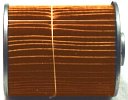 <- With String - String Removed ->
<- With String - String Removed ->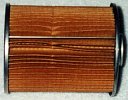
As you may be able to tell, the string did not rip into the filter element, it only crushed it. There was no evidence that the element had been compromised. Out of the 8 Purolator filters (and clones) tested, this was the only one with a problem.
Purolator has been around since the dawn of oil filters. The first original equipment automotive oil filter application was for the Chrysler Six back in 1923. That filter was called a "Purolator" (pure oil later). They also claim to have produced the first full-flow oil filter in 1943, the first pleated paper filter in 1946, and the first spin-on oil filter in 1955.
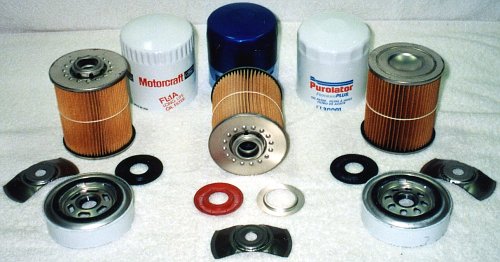
Left to Right: Motorcraft, Purolator Pure One, Purolator Premium Plus
Here is a fairly well designed filter, especially for the price. One odd thing about Purolator's filters is a string that is always wrapped around the filter element. I assume that this is there to hold the element in place while the glue in the end caps cures. Of all the Purolator-based filter I tested, there was one (the ProLine) that had filter element damage from this string. It was only one of the ten or so Purolator filters disassembled. Even though the element was crushed a bit, it was not ripped.
The Purolator filter elements generally have the highest surface areas out of all the filters in their price range (and in general). This filter cartridge has an impressive surface area of 316 sqin. It features a spring-loaded metal bypass valve and a nitrile rubber diaphragm-type anti-drainback valve, which doubles as the seal between the backplate and the cartridge. The bypass valve is stamped right into the bottom end cap of the cartridge, so it is all one piece.
Sometime before 2008, the cartridge seems to have changed slightly. The bypass valve moved from the front to the back of the cartridge. The shape of the plate at the front is slightly different, but not in any obviously meaningful way.
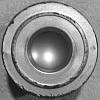
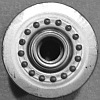
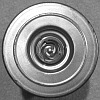
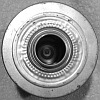
1999 Purolator on the left, 2008 Purolator on the right
The telltale sign for a Purolator filter are: 8 medium-sized holes for the oil inlet and nothing but a black (or orange for the Pure One) diaphragm to be seen through them. There are 6 large crimps holding the gasket in place. Through the center outlet hole, you can see the spring for the bypass valve.
Exploded view and backplate:

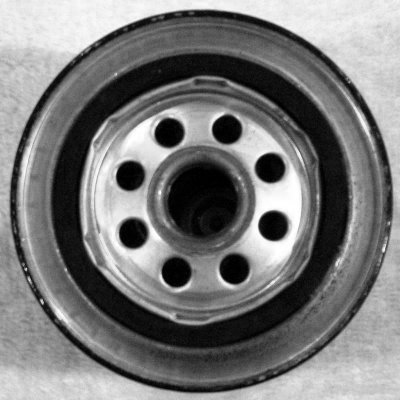
| Average Retail Price | $3 |
| Cartridge Length | 4.13 inches |
| Cartridge Outside Diameter | 3.25 inches |
| Cartridge Inside Diameter | 1.63 inches |
| Cartridge Pleats | 51 |
| Cartridge End Cap Type | Stamped-steel, with bypass valve in back |
| Anti-Drainback Valve Type | Nitrile rubber diaphragm |
| Bypass Valve Type | Spring-loaded steel |
| Element Type | Paper media, stamped metal seam |
| Element Length | 79.0 inches |
| Element Width | 4.00 inches |
| Element Surface Area | 316 square inches |
| Shell Thickness | 0.011 inches |
| Backplate Thickness | 0.12 inches |
| Gasket Type | Nitrile rubber |
This filter has a few improvements over the Premium Plus. It has a denser synthetic filter media to filter out smaller particles and more surface area to make up for the flow restriction. Aside from those the cartridge is the same construction as the Premium Plus.
The filter cartridge has an even more impressive surface area of 400 sqin. The potential issue is that this filter element is compressed into even more pleats (64) than the Premium Plus. This may restrict flow more than it helps relieve it, but it is hard to say for sure as the siping in the pleats are supposed to keep the pleat gaps open. It also features a spring-loaded metal bypass valve and a silicone rubber diaphragm-type anti-drainback valve, which doubles as the seal between the backplate and the cartridge. The bypass valve is located at the back of the cartridge, not at the front. The gasket is PTFE-treated for easier installation and a better seal.
| Average Retail Price | $6 |
| Cartridge Length | 4.13 inches |
| Cartridge Outside Diameter | 3.25 inches |
| Cartridge Inside Diameter | 1.63 inches |
| Cartridge Pleats | 64 |
| Cartridge End Cap Type | Stamped-steel, with bypass valve in front |
| Anti-Drainback Valve Type | Silicone rubber diaphragm |
| Bypass Valve Type | Spring-loaded steel |
| Element Type | Synthetic media, stamped metal seam |
| Element Length | 100.0 inches |
| Element Width | 4.00 inches |
| Element Surface Area | 400 square inches |
| Shell Thickness | 0.011 inches |
| Backplate Thickness | 0.12 inches |
| Gasket Type | Nitrile rubber, PTFE-treated |
This filter makes the most effective use of its inside space of any filter I have seen to date. The case length is one of the longest as well, which might be a clearance concern for some. It has the longest cartridge as well as the longest filter element out of all the filters. This gives it by far the largest surface area of any filter on this page: 490 sqin. The bypass valve is a spring-loaded steel valve located at the back of the cartridge. The cartridge is held in place using a stiff coil spring.
Unfortunately, these filters are made in Australia and are hard to come by in the US. I received this filter back in 1999 from a fellow enthusiast down under and I really wish I had torn it apart earlier. I'd like to see a 2008 version if anyone can give me a lead on one.
Exploded view:

| Average Retail Price | ? |
| Overall Length | 5.56 inches |
| Overall Diameter | 3.64 inches |
| Cartridge Length | 4.50 inches |
| Cartridge Outside Diameter | 3.38 inches |
| Cartridge Inside Diameter | 1.51 inches |
| Cartridge Pleats | 64 |
| Cartridge End Cap Type | Stamped-steel, with bypass valve in back |
| Anti-Drainback Valve Type | Nitrile rubber diaphragm |
| Bypass Valve Type | Spring-loaded steel |
| Element Type | Cellulose |
| Element Length | 112 inches |
| Element Width | 4.38 inches |
| Element Surface Area | 490 square inches |
| Shell Thickness | 0.019 inches |
| Backplate Thickness | 0.095 inches |
| Gasket Type | Nitrile rubber |
STP acquired Champion Labs in 1970 and uses them to make their STP-branded oil filters. The 2008 version is now using their "Ecore" design.
2008 Version (Ecore)
| Average Retail Price | $3 |
| Overall Length | 4.50 inches |
| Overall Diameter | 3.65 inches |
| Cartridge Length | 3.56 inches |
| Cartridge Outside Diameter | 3.24 inches |
| Cartridge Inside Diameter | 1.79 inches |
| Cartridge Pleats | 57 |
| Cartridge End Cap Type | Fibrous material |
| Anti-Drainback Valve Type | Nitrile rubber diaphragm (shared) |
| Bypass Valve Type | Nitrile rubber diaphragm (shared) |
| Element Type | Paper media, glued seam |
| Element Length | 86.5 inches |
| Element Width | 3.44 inches |
| Element Surface Area | 297 square inches |
| Shell Thickness | 0.015 inches |
| Backplate Thickness | 0.090 inches |
| Gasket Type | Nitrile rubber |
1999 Version
| Average Retail Price | $3 |
| Cartridge Length | 4.00 inches |
| Cartridge Outside Diameter | 3.25 inches |
| Cartridge Inside Diameter | 1.63 inches |
| Cartridge Pleats | 58 |
| Cartridge End Cap Type | Stamped-steel, with bypass valve |
| Anti-Drainback Valve Type | Nitrile rubber diaphragm |
| Bypass Valve Type | Spring-loaded steel, nitrile seal |
| Element Type | Paper media, glued seam |
| Element Length | 93 inches |
| Element Width | 3.88 inches |
| Element Surface Area | 360 square inches |
| Shell Thickness | 0.012 inches |
| Backplate Thickness | 0.10 inches |
| Gasket Type | Nitrile rubber |
WIX has been making replacement oil filters since 1939, though they may be better known for producing some of the first full-flow "spin-on" oil filters the mid 1950s. Most oil filters sold today are full-flow, spin-on types. They also were the first to mix pumice in the outer shell paint to make the cans "grippy". They merged with Dana in 1979. WIX filters are used in OEM applications and sold as the in-house brands of several auto parts stores, such as Car Quest and NAPA. They both sell low and high-end versions of these WIX filters, with the main difference being the filter element surface area and possibly the composition of the filter element (though there is no claim to that effect that I can find).

WIX (left) compared to 1999 STP/Champion (right)
This filter has metal cartridge end caps, but has a separate bypass valve assembly that rests against the front end cap. I refer to this as a two-piece filter cartridge. The separate valve takes some of the internal filter space from the filter cartridge itself, which is something to consider for shorter filters (see the Car Quest and NAPA Toyota filters for an example). It uses an anti-drainback valve that doubles as the bypass valve-to-backplate seal. Instead of the leaf spring spacer that most filters use, these use a stiff coil spring at the top of the cartridge. The only drawback to this design is that the bypass valve seats metal-to-metal against the bottom cartridge end plate. This could allow dirty oil to seep from the dirty side to the clean side of the filter, bypassing the element. The design will not allow oil to seep back into the pan, though and the amount of oil that can get past is probably negligible.
The telltale signs for a WIX are: 6 large holes for the oil inlet with only the black anti-drainback valve to be seen through them. There are 6 "notches" that hold the gasket in place. Through the center outlet hole, you can see the bypass valve spring. Usually the backplate metal is shiny.
This filter features a good surface area, but a lot of shallower pleats. This makes them similar to the Purolator's pleats.


| Average Retail Price | $5 |
| Cartridge Length | 4.00 inches |
| Cartridge Outside Diameter | 3.25 inches |
| Cartridge Inside Diameter | 1.63 inches |
| Cartridge Pleats | 61 |
| Cartridge End Cap Type | Stamped-steel |
| Anti-Drainback Valve Type | Nitrile rubber diaphragm |
| Bypass Valve Type | Spring-loaded steel, nitrile seal |
| Element Type | Paper media, glued seam |
| Element Length | 90 inches |
| Element Width | 3.88 inches |
| Element Surface Area | 349 square inches |
| Shell Thickness | 0.014 inches |
| Backplate Thickness | 0.10 inches |
| Gasket Type | Nitrile rubber |
One thing should be pretty clear if you have made it through this entire article. While there are dozens of oil filter brands out there, there are only a few actual manufacturers. Most filters you see on the shelf are sold by companies that don't actually make oil filters. The exceptions are Baldwin/Hastings, Champ, Donaldson, Purolator, and Dana/WIX. Those are actual manufacturers and you can be fairly certain of what is inside the can. Although Fram hasn't made filters in decades, it seems that the brand is tied closely enough to Honeywell that you can be pretty sure about what is in the orange can (for better or for worse). Most other brands contract one of these companies to make filters for them. They seem to change from time to time, so one has to be vigilant when purchasing one. See the overview page for a quick manufacturer reference including images of their backplates.
If you want to hear my opinion take a look at the Oil Filters Revealed: Opinions and Recommendations page. Which filter is the best? There is no easy answer to that one. It depends on what kind of oil you use and how much you are willing to spend.
| Return to Oil Filters Revealed |
Updated 02/19/2008.
Copyright © 1996-2008 Russ W. Knize.